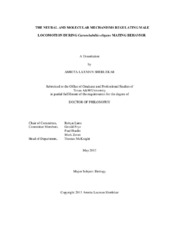| dc.description.abstract | In key survival behaviors like predator-prey interactions and mating, animals have to integrate dynamic sensory inputs from a moving target and regulate their motor outputs on moment-to-moment basis. The molecular underpinnings of such goal-oriented behaviors are not well understood because of the genomic and neural system complexities of many animals. Here I take advantage of the anatomical simplicity of the nematode worm Caenorhabditis elegans and its amenability to optogenetics to interrogate the neural mechanisms underlying male mating behavior. Male mating is a goal oriented behavioral sequence and serves as a useful paradigm for exploring neural control of sex-specific behaviors, behavioral sequence execution and decision-making. When not engaged in mating the male, like the hermaphrodite, explores his environment with predominantly forward locomotion. However, when the male contacts a potential mate he immediately places his tail against her surface and searches for the vulva, moving backwards. Male-specific sensory rays of the tail are responsible for sensing mate contact, inducing tail apposition and backward movement. Using a combination of cell-specific laser ablation, optogentics and mutant analyses, I show that the male exploits the sex-shared locomotory system to control his mating movement. The rays exert their affect by acting through at least two downstream pathways. One pathway is defined by male-specific interneurons PVY and PVX which activate backward command interneurons AVA(L/R) and shift the directional bias to backward. This AVA activation is mediated by cholinergic receptor subunits ACR-18, ACR-16 and UNC-29, which is an atypical mode for command interneuron regulation. The second pathway is defined by male-specific interneurons EF1-3. EFs may promote backing by inhibiting sex-shared AVB(L/R) forward command interneurons. Upon vulva detection by the hook sensilla, locomotion ceases by the redundant action of hook neurons HOA and HOB. Surprisingly, PVY/PVX and EFs activity is required for holding the tail at the vulva. Taken together these data suggest that a distributed processing strategy underlies male’s accurate, rapid and robust movement control during mating. The male-specific nature of his behavior is due male-specific control of sex-shared circuitry. Conceivably, similar design and processing strategies may underlie the circuitry controlling analogous behaviors in more complex nervous systems. | en |


